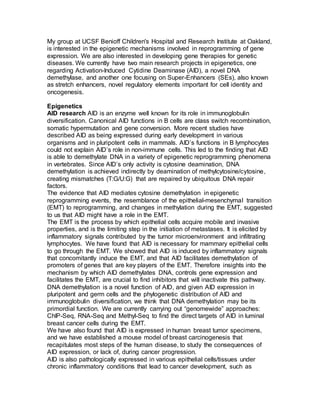
Descrption of my group 12-7-15
- 1. My group at UCSF Benioff Children's Hospital and Research Institute at Oakland, is interested in the epigenetic mechanisms involved in reprogramming of gene expression. We are also interested in developing gene therapies for genetic diseases. We currently have two main research projects in epigenetics, one regarding Activation-Induced Cytidine Deaminase (AID), a novel DNA demethylase, and another one focusing on Super-Enhancers (SEs), also known as stretch enhancers, novel regulatory elements important for cell identity and oncogenesis. Epigenetics AID research AID is an enzyme well known for its role in immunoglobulin diversification. Canonical AID functions in B cells are class switch recombination, somatic hypermutation and gene conversion. More recent studies have described AID as being expressed during early development in various organisms and in pluripotent cells in mammals. AID’s functions in B lymphocytes could not explain AID’s role in non-immune cells. This led to the finding that AID is able to demethylate DNA in a variety of epigenetic reprogramming phenomena in vertebrates. Since AID’s only activity is cytosine deamination, DNA demethylation is achieved indirectly by deamination of methylcytosine/cytosine, creating mismatches (T:G/U:G) that are repaired by ubiquitous DNA repair factors. The evidence that AID mediates cytosine demethylation in epigenetic reprogramming events, the resemblance of the epithelial-mesenchymal transition (EMT) to reprogramming, and changes in methylation during the EMT, suggested to us that AID might have a role in the EMT. The EMT is the process by which epithelial cells acquire mobile and invasive properties, and is the limiting step in the initiation of metastases. It is elicited by inflammatory signals contributed by the tumor microenvironment and infiltrating lymphocytes. We have found that AID is necessary for mammary epithelial cells to go through the EMT. We showed that AID is induced by inflammatory signals that concomitantly induce the EMT, and that AID facilitates demethylation of promoters of genes that are key players of the EMT. Therefore insights into the mechanism by which AID demethylates DNA, controls gene expression and facilitates the EMT, are crucial to find inhibitors that will inactivate this pathway. DNA demethylation is a novel function of AID, and given AID expression in pluripotent and germ cells and the phylogenetic distribution of AID and immunoglobulin diversification, we think that DNA demethylation may be its primordial function. We are currently carrying out “genomewide” approaches: ChIP-Seq, RNA-Seq and Methyl-Seq to find the direct targets of AID in luminal breast cancer cells during the EMT. We have also found that AID is expressed in human breast tumor specimens, and we have established a mouse model of breast carcinogenesis that recapitulates most steps of the human disease, to study the consequences of AID expression, or lack of, during cancer progression. AID is also pathologically expressed in various epithelial cells/tissues under chronic inflammatory conditions that lead to cancer development, such as
- 2. ulcerative cholitis, Crohn’s disease and infections with Hepatitis C virus and Helicobacter pylori. We have found that AID is induced upon NOD1 signaling in colon cancer cells, and that AID is necessary for the expression of the inflammatory cytokine interleukin-6 (IL6), under the same stimulus. IL6 secretion generates a positive feedback loop that maintains inflammation, AID expression and promotes tumorigenesis, therefore implicating AID as a cancer progression factor, once inflammation is initiated. We are currently using mouse models (wild type and AID KO mice) to establish the mechanism/s of AID induction under chronic inflammatory conditions and its consequences in the pathophysiology of ulcerative cholitis and Crohn’s diseases. Super-enhancer research Super-enhancers (SEs) are clusters of transcriptional enhancers that function as units to regulate expression of genes that are key for cell identity, survival, and oncogenesis. They have recently been identified in multiple human cell types and cancers, and are particularly enriched in acetylated H3K27 and chromatin binding factors such as the Mediator complex. Disruption of SEs impairs cancer cell survival. Expression of genes that are regulated by SEs is extremely sensitive to mild variations in the amount and/or composition of the transcription factors and cofactors bound to the SEs. These genes usually encode key regulators of tumor cell state. SEs are bound by transcriptional activators, but they differ from canonical enhancers in size, transcription factor density and content, ability to activate transcription, and perhaps most importantly, sensitivity to perturbation. Characterization of SEs has proven to be an extremely useful tool to find new transcriptional regulatory nodes, and producing several oncogene candidates to be considered as therapeutic targets. We are characterizing SEs in a variety of child and adult tumors by ChIP-Seq and characterizing the factors necessary for their de novo formation by en-ChIP. The purpose of cataloguing SEs is to identify genes, transcription factors, and regulatory elements important for carcinogenesis and progression. These comparative and comprehensive studies may uncover new regulatory circuits that are characteristic of specific cancers in general, or of specific cancer subtypes. We have improved existent algorithms for SE calling and used them to identify several SEs in breast cancer cells that regulate the expression of new factors that may have a role in breast cancer. We are testing the function of these SEs by a novel strategy using the recently developed CRISPR system that permits targeted disruption of chromatin function. We are also using the epigenetic datasets generated through these studies and publicly available ones to perform integrated bioinformatic analysis for better stratification of various cancers and identification of tissue of origin.
- 3. Gene Therapy Hemoglobinopathies Another area of interest is the development of a gene therapy for the treatment of hemoglobinopathies such as sickle cell disease and some -thalassemias. We are using the CRISPR system to deliver genetic modifications into hematopoietic stem cells (HSCs) that once transplanted are able to reconstitute the immune system of the patient. Since this therapy involves an autologous transplant there is no need to look for matching donors, and poses no complications from graft rejection. We are designing and testing various strategies to maximize the correction rate in HSCs.